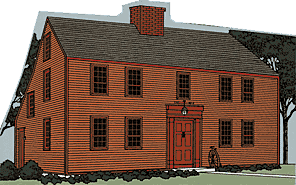In 1685, the Irish lord sold a portion of his parcel to a Charlestown man called "Roe." I have seen references to this man being named "Elias Rowe" as well as "Mr. Munroe" (who shortened his own name to "Roe."). The deed that Roe purchased referred to the land "so much in the wilderness" -- as it was wooded and as well suited for hunting bears and wolves as it was for farming. The specific parcel of land purchased by Rowe was probably roughly bounded on the North by what is today Medford St. and on the South by what is today Oxford St. (one block south of Highland). One record indicates that the parcel totaled 43 acres though by my calculation this area is somewhat larger (~57 acres).
Roe had one child, a girl named Ruth. Ruth married a man by the name of Mattison or Watson (I have seen references to both) who cleared the land and built the house. Their family owned the land until 1778.
 Mr. Mattison (or Watson) built what we refer to as the Oliver Tufts House between 1714 and 1719 from timber and stock cut on the land. He also cleared the land for farming. Records indicate that the house was likely built in the "Saltbox" style which was popular in that day. Residents of the house from the late 1700's are quoted describing the house as being two stories high in the front and one story high in the rear, with a long sloping roof. While I have not yet found any depictions of the house from this time period I have included an illustration of a typical Saltbox Colonial (courtesy of the "Hometowne Collectibles Co." website http://www.htowne.com/items/itemhtNE05.asp) which indicates what the house must have looked like.
Mr. Mattison (or Watson) built what we refer to as the Oliver Tufts House between 1714 and 1719 from timber and stock cut on the land. He also cleared the land for farming. Records indicate that the house was likely built in the "Saltbox" style which was popular in that day. Residents of the house from the late 1700's are quoted describing the house as being two stories high in the front and one story high in the rear, with a long sloping roof. While I have not yet found any depictions of the house from this time period I have included an illustration of a typical Saltbox Colonial (courtesy of the "Hometowne Collectibles Co." website http://www.htowne.com/items/itemhtNE05.asp) which indicates what the house must have looked like.
The house originally sat on the knoll that is presently the corner of Sycamore and Pembroke streets, and if not moved would presently overlap both of those streets. It had, from this slightly raised vantage point, a view of Boston Harbor (which is part of what made it attractive as a military commandpost sixty years later). Sycamore St. was the original private driveway to the house from Barberry Lane (a country road that, in this area, roughly followed the course of the modern Highland Ave.). It is not clear to me how far back Barberry Lane or this driveway date. They do not appear on any maps that I have found prior to the 1800's however this is not evidence of their nonexistence.
Ruth Mattison continued living in the south side of the house and maintained an interest in half of the farm and its products after her husband's death. When Ruth died, the family moved to Lyme, Connecticut and left the house vacant. One article indicates that an Isaac Fillebrown occupied the house for a short time before the Revolution, presumably renting/leasing the property from the Mattison family.